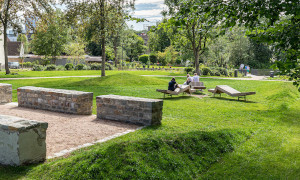By Sylvia Butenschön
One hundred years of Bauhaus - there is no getting around the anniversary of this world-famous school of architecture and design this year.
What do we as landscape architects have to do with this, what is our relationship to the Bauhaus? In our discipline, we talk about post-war modernism as a matter of course. And what is our modernity?
There was no garden art class and no open space design teacher at the Bauhaus.
There was no garden art class and no open space design teacher at the Bauhaus, even though Heinz Wichmann made an attempt to change this in 1924. He envisioned a theoretically sound artistic design training for gardeners, which was to be practice-oriented through exemplary implementations of student designs. In principle, this idea was well received by the Bauhäusler - but in the end it could not be realized.
The architects and artists remained among themselves, yet continued to propagate the holistic approach to design and the conscious connection of interior and exterior in architecture. Gropius placed the master houses in Dessau on lawns between existing pine trees. This ensemble thrives on the contrast between the cubic, clear structures and the vegetation, which forms a loose framework in a calm colour scheme. Other gardens on Bauhaus buildings were not so reduced, but contemporary - and that means stylistically and functionally as high quality and as varied as landscape architecture was during the Weimar Republic.
Gestalt reform in our discipline had already occurred in the first decade of the 20th century.
The reform of design in our discipline had already taken place in the first decade of the 20th century - through competitions and major horticultural exhibitions, a new formal language had become established in the garden. Inspired by architects and artists, young landscape architects also took up the formal-architectural style and designed gardens in which the formation of space by lowering and raising, hedges and walls as well as perspective views played a decisive role. Such modern or "new-age" gardens were designed all over the republic, for example in the offices of Ochs (Hamburg), Roselius (Bremen) or Pniower (Berlin - to name just a few explicitly.
Beyond form, it was questions of how to deal with the essential building material, the plant, that led to innovations in the design of gardens and parks. In his garden design of the modern era, Willy Lange advocated the idea of imitation and artistic exaggeration of natural plant communities. Even if this biological-ecological garden style had nothing in common in its aesthetic effect with the simple cubic architectural forms of the new building - in the concept of material justice architecture and garden architecture coincided here. A completely different approach was evident in the expressive way in which plants were used, with designers relying on the intense colour effects of uniformly planted, often geometric areas, as Allinger did in his ornamental planting at the Jubilee Horticultural Exhibition in Dresden in 1926.
But beyond the form, is it not the content, the functional and the social, which actually constitutes the new, the green utopia of this time? With the ideas of Migge, Maasz and Lesser for small gardens, residential green spaces and urban green spaces, our modernism goes beyond the individual object to include the spatial context and the new social conditions as content requirements in the design process. And is thus at least as modern as a white low-rise building!
Author: Dr.-Ing. Sylvia Butenschön, Landscape Architect bdla, Institute for Urban and Regional Planning, Department of Historic Preservation, Technical University of Berlin. The text appeared in the bdla association magazine "Landschaftsarchitekten" 1/2019.
- Latitude: 0
- Longitude: 0


